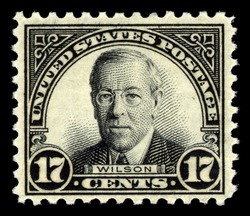
| Name | Value |
|---|---|
| Date of Issue | December 28, 1925 |
| Year | 1925 |
| Denomination |
17¢
|
| Denomination Value | $0.17 | Color | Bank note black |
| Series | Ordinary Postage Stamps - Issue of 1922 |
| Series Time Span | 1925 |
| Issue Location | Washington, D.C., Princeton, N.J., New York, N.Y., and Staunton, Va. |
| Size | 75/100 by 87/100 inch, |
| Postal Administration | United States |

| Condition | Name | Avg Value |
|---|---|---|
|
M-NH-VF
|
Mint - Never Hinged - Very Fine | View price |
|
M-NH-F
|
Mint - Never Hinged - Fine | View price |
|
M-NH-VG
|
Mint - Never Hinged - Very Good | View price |
|
M-H-VF
|
Mint - Hinged - Very Fine | View price |
|
M-H-F
|
Mint - Hinged - Fine | View price |
|
M-H-VG
|
Mint - Hinged - Very Good | View price |
|
M-NG-VF
|
Mint - No Gum - Very Fine | View price |
|
M-NG-F
|
Mint - No Gum - Fine | View price |
|
M-NG-VG
|
Mint - No Gum - Very Good | View price |
|
U-VF
|
Used - Very Fine | View price |
|
U-F
|
Used - Fine | View price |
|
U-VG
|
Used - Very Good | View price |
A new postage stamp of 17-cent denomination, bearing the portrait of Woodrow Wilson, was issued and first placed on sale December 28, 1925, at Washington, D.C., Princeton, N.J., New York, N.Y., and Staunton, Va.
The stamp is the same shape and size, a horizontal rectangle, as the 20-cent stamp of the series of 1922–23, and is printed in bank note black ink. The central design is a portrait of Woodrow Wilson within a semicircle and is partly inclosed in a panel which is supported on either side by acanthus scrolls. Within this panel and above the portrait appear the words "United States postage" in white Roman letters. On a ribbon below the portrait is the name "Wilson" and under this, at the bottom of the stamp, appears the word "Cents." In both lower corners, within circles with dark backgrounds, are the white numerals "17." Triangular white-line ornaments appear in both upper corners and the entire stamp is inclosed within a single white-line border.
The new stamp was issued primarily for use in prepaying a single rate of letter postage and registry fee and was also available to the amount of its value for other purposes for which ordinary postage stamps are used.
This series of postage stamps was issued to replace the regular issue of stamps, known as the "Series of 1912."
There are 21 denominations in this series, each having a different subject as the central design and with larger numerals denoting the denominations.
The designs are most artistic and were selected with the view of giving historical and educational interest to the stamps.
Three different border designs were used for this series of stamps, which are the same size, 75/100 by 87/100 inch, as the 1912 issue.
The border design for the first 13 denominations (1-cent to 14-cent) is identical. A different border design was used for the 15-cent denomination and still another border design for the remaining seven denominations (20-cent, 25-cent, 30-cent, 50-cent, $1, $2, and $5).